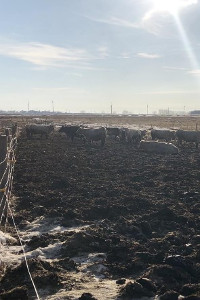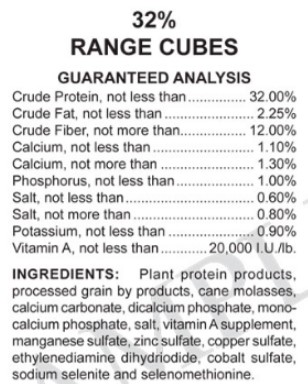By Alvaro Garcia

Every late winter and early spring beef producers usually face the same problem. Whether it is pooled water resulting from melting snow or excessive rainfall, they both lead to mud accumulation. Walking through deep mud to take care of cattle requires additional effort by the rancher. Every time we lift a foot to take another step, it seems as if the ground acts as a suction cup and does not want to let go. Beef cows slogging through the mud face a similar challenge, having to move roughly 1,200 pounds through the mud! This movement requires energy expenditure, which reduces the efficiency of feed conversion into body reserves. Cows early in spring have an additional challenge; they are likely nursing a calf, which also requires more energy. A few years ago, University of Nebraska Lincoln researchers determined how much energy was lost depending on how deep the mud was. Since then however, other research reports considered additional factors for a more accurate prediction. Cows that lie down on cold, wet ground also lose energy through heat conduction. In this scenario, cows also have wet and matted hair coats reducing its insulation properties, and increasing their energy losses through heat convection. The extent of these losses vary depending on ambient temperatures and wind speed. This is particularly important for their young calves since they have less body mass and fat insulation and as a result, their core body temperature drops faster. There is no way to know for sure how long on a given year we will have to rely on stored feed. Since stored forage resources are finite, it makes more sense to reduce first the energy losses, than try to feed our way out of this situation. In other words, if a tank loses water through a leaking pipe do you continuously add more water or do you first fix the pipe?
Reducing Energy Losses
CONVECTION
There are some options in order to cope with this situation. Producers can reduce cattle energy losses by convection by using permanent or moveable windbreaks. These can be tree/shrubs shelterbelts, a metal or wood structure or even stacked round bales (two rows high). Wind shelters can reduce calving losses and speed-up cows’ return to normal cycling activity. The windbreak design will depend on its intended purpose, snowdrift protection, wind, etc. They allow some air to go through which makes them more resistant to strong winds. According to research, the optimum open spacing to protect from both wind and snowdrifts is roughly between 25 and 33% of the total area covered by the windbreak. Research also suggests that a windbreak 10 feet high will protect an area of roughly 80 to 100 feet.
CONDUCTION
There is not much to do in order to reduce energy losses by conduction except to have drier ground. The obvious solution would be to move the cows to a drier lot together and add a portable shelterbelt. Not every rancher has the means to accomplish this. However, putting together a temporary shelterbelt with round bales in a drier spot is an option to explore. If deciding to go that route the shelter should be two bales high, with the bottom bales upright and the top bales horizontal to reduce the chances of them tipping over. Another alternative is straw bedding to provide some insulation from the ground.

Increasing Energy Supplied
When there is excessive mud cows reduce intake, which results in more wasted feed, particularly of forage. To improve their energy balance, there is a need to offer a feed of higher digestibility. According to research 4-8 inches of mud, reduces intake by 15 percent when compared to drier ground. If mud increases by an additional 50 percent, feed intake drop doubles (30%). For cow-calf pairs early in the calving season, the negative effect on intake affects the cows more, since claves are eating very little forage at the time. The performance of young calves’ can also suffer at this stage, since they still rely heavily on the cow’s milk as the main source of nutrients and this one drops as a result of less feed intake.
One approach to improve intake is to reduce the distance the cows travel to the feeding area. Similarly, access to relatively close, clean water improves intake. Providing access to fresh trace mineral supplements also enhances feed digestion and intake. When left on the ground, rain, snow, and pooled water washout white salt and essential minerals from mineral blocks and reduces their acceptability by cattle.
Supplemental forages for beef cows are usually high in fiber and as a result low in energy and borderline to low in protein. Examples of such are mature grass hay, ditch hay, cereal grain straws, and corn stalks. In addition, even if an analysis of the roughage in question contains borderline adequate percentages of crude protein (i.e. 10 %) and energy as TDN (i.e. 58%), remember cows do not eat “percentages” but “pounds” of nutrients. A 1,200-pound lactating beef cow needs 3 pounds of protein and 17.6 pounds of TDN. Under good environmental conditions, she can eat 2.5 percent of her body weight as dry feed or 30 pounds. If the diet contains 10 percent protein and 58 percent TDN, the cow eats 3 pounds of protein and 17.4 pounds of TDN, almost exactly what she needs.
Today’s commercial beef cows can produce around 20-25 pounds of milk daily at peak lactation, with high concentration of protein and fat. Her intake under 8” of mud can decrease by 15 percent which, in this example, will be around 26 pounds of dry feed, 2.6 pounds of protein, and 15 pounds of TDN. If we do not fulfill the greater protein and energy needs of early lactation, forage fermentation drops and as a result so does energy uptake, delaying the return to normal breeding cycles. Cows fed these forages will greatly benefit from high protein cubes or tubs. There are several offered in the market some with minimums of 20, 32, and 38-40 percent protein. In this example with 8” of mud, since the cow diet is deficient in 0.4 pounds of protein (3 – 2.6 = 0.4), it would be enough to offer 1.5 pounds of a 32 percent cube per head daily (0.48 pounds of protein supplemented). This supplementation will encourage the cow to eat more forage, better digest the fiber, increasing the TDN of the overall diet.
Muddy conditions do not just mean dirty looking beef cows. If not adequately, supplemented nutrient uptake will not meet the requirements of the cow in early lactation. Under these conditions, not only calf growth but also rebreeding are negatively impaired affecting the farm bottom line.
Source: sdstate.edu